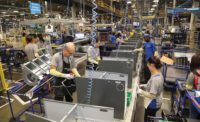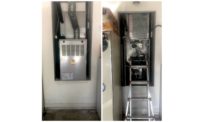Homeowners are growing accustomed to technological advancements in nearly every area of their lives. Intelligent technology is already reaching into homes with advancements such as smart thermostats and smart lightbulbs, but some homeowners may still be unaware of all the benefits of high-end, intelligent HVAC. Contractors can benefit from knowing the advantages of high-end comfort technology, how to service it, and how to sell it.
Why High-End HVAC?

QUIET AND CALM: According to Todd Nolte of Carrier, quiet operation is one thing that sets high-end HVAC apart. (Courtesy of Carrier)
“Cutting-edge air conditioning systems offer more than just one single high-end feature,” said Bart Balthazor, residential product manager, ducted systems, Johnson Controls. “They’re a compilation of multiple aspects that, together, make a smart home comfort system that offers homeowners efficient performance, worry-free reliability, and customizable functionality that fits their family’s lifestyle.”
High-end HVAC offers a range of benefits including efficiency, reliability, interconnectivity, and enhanced comfort. Homeowners, most of the time, do not want to think about their HVAC system. They want it to do its job silently, preserving comfort while being both out of sight and out of mind.
According to Todd Nolte, senior director, product strategy and regulatory, HVAC-residential, Carrier, the ability to operate quietly is one thing that sets high-end apart, sometimes operating as low as 51 dB.
Smart connectivity, coupled with an intuitive user interface, helps keep HVAC out of sight for the homeowner as well. High-end systems offer app-based controls, meaning that homeowners can set preferences and system parameters with a few swipes. They can set schedules for the temperature of their home or even of individual rooms, if zoning is in order.

LUXURY: Chad Gillespie, METUS, said that luxury homes often include heating, cooling, humidity control, and IAQ. (Courtesy of METUS)
Chad Gillespie, senior manager, performance construction, Mitsubishi Electric Trane HVAC US (METUS), said that luxury homes will have systems that go beyond the simple air conditioner and furnace. Heating and cooling is a must, but these homes may also have fresh air systems for ventilation, as well as a humidifier or dehumidifier. This opens up a number of different options for contractors to profit from: traditional ducted systems with a furnace and air conditioner, but also mini-split heat pumps (with ductless or ducted units), geothermal, radiant, or a combination of the above.
“Energy recovery ventilators (ERV), heat recovery ventilators (HRV), and ventilating dehumidifiers are becoming more important as we design with tighter envelopes and homeowners demand optimal air quality,” said Gillespie.
Communication also allows for the thermostat and the units to share information and make the proper adjustments to ensure that comfort is maintained at the highest level of efficiency possible. Higher efficiency means that the homeowner sees lower bills and less need for additional heat. With the wide range of comfort systems available, this efficiency increase also allows homeowners to see returns in better managing their humidification control systems.
The Pandemic and High-End HVAC
HVAC contractors are well aware that interest in indoor air quality has grown dramatically as a result of the pandemic. This increased interest also leads to opportunities for contractors in the high-end sector of the market.
Mark Woodruff, senior product manager of outdoor products, Trane, said that before the pandemic, many people took the technology in commercial buildings for granted. They would go to their office, enjoying an indoor environment that incorporated aspects like humidity control systems, efficient air filtration, and VOC removal systems.
“Because people are spending more time at home, they’re beginning to take notice of their living conditions and want to be just as comfortable at home as they were in their office buildings before the pandemic,” Woodruff said. “People are willing to spend a little more money to get a system that will give them an experience more like what they have had in their old workplaces.”
This means that people are more willing to add features to their homes such as high-efficiency air filters, fresh air ventilators, dampers, and humidifiers/
dehumidifiers. Some people are even upgrading to homes with dedicated offices, and they want to fix the issues that stop them from achieving their maximum comfort in their homes.
Brandon Chase, senior product marketing manager, Lennox Industries, mentioned that high-end systems that can manage indoor air quality have become popular for features such as automatic operation adjustments that can respond to environmental conditions (taking into account factors such as the presence of pollen, for example). High-end air conditioning systems can pair with IAQ equipment, working together to create an ideal home environment.
Stanford University found that more than a third of Americans are currently working from home, and the International Energy Agency predicted that working from home could raise residential energy consumption as much as 23%.
“This is leading homeowners to search for ways to reduce their energy usage and monthly bills, looking to high-efficiency, variable capacity systems as a key solution,” said Balthazor. “Modern, top-tier HVAC systems can support these goals while demonstrating the value of first cost versus total cost of ownership over the life span of the unit.”
Zoning can even allow each family member to customize their own indoor workspace, balancing multiple people’s comfort interests. Interest in ventilation is also increasing as homeowners realize the benefit of bringing fresh air into the home. More people may be looking for ERVs and HRVs, according to Carrier’s Nolte.
Servicing and Maintaining High-End HVAC
High-end systems offer technology that allows both preventative maintenance and service to be done faster and more accurately. Some systems offer touchscreen displays that can show details such as the general system condition and refrigerant charger, rather than requiring manifold gauges. If the homeowner grants access, the system’s information can be monitored remotely. This means that contractors can know the tools needed for a job before they arrive on-site, and it can remove or limit the need for technicians to enter a home and physically work on a system.
Technicians still need to understand the technology involved in a high-end system.
“Systems may be tied together or decoupled, so attention to how they work together is imperative,” said Gillespie. “They will also require different maintenance schedules from traditional units, depending on what types of systems are used.”
High-end also offers built-in diagnostics that are continuing to improve. Diagnostic trouble codes can offer repair data to a technician, allowing for technicians to arrive to a home with the correct tool and parts, saving a trip.
“Today’s high-end heating equipment offers unprecedented ease in installment, granular system control from anywhere, and advanced methods for diagnosing and reporting system issues by service technicians,” said Woodruff.
How to Sell High-End HVAC to Homeowners
High-end technology can offer loads of benefits to homeowners, but only if contractors know how to communicate and sell these benefits in the right way. Contractors can use remote diagnostics to proactively reach out to their customers and remedy an issue, gaining trust and a sale. Chase said that contractors need to adjust their selling techniques to customers’ changing needs and wants, such as smart controls, efficiency, connectivity, and noise reduction. Gillespie reminded contractors that educating themselves upfront on the benefits, and then their customers, can pay off in the long run, as often homeowners will accept a contractor’s base system without even knowing a better system is available.
“The most important factors for most homeowners are the value propositions and if they find value in higher-end systems,” said Casey Yates, vice president of channel sales, ducted systems, Johnson Controls. “Contractors need to take a two-step approach when discussing this with homeowners. The first is reviewing the lifecycle cost of buying a higher-priced system and the utility savings it will provide the homeowner. The second is reviewing the improved comfort level that variable-speed technology will deliver to their home, along with the benefits that enhanced humidity control can have on their home.”
Contractors should also not skip out on discussing ventilation options. ERVs or HRVs, combined with a high-end system, can further enhance the efficiency, comfort, IAQ, and humidity control.





